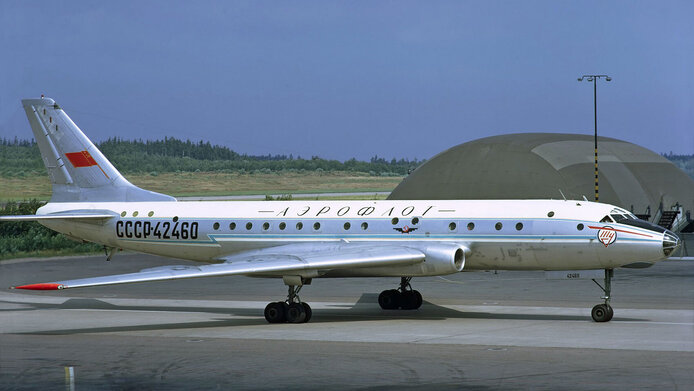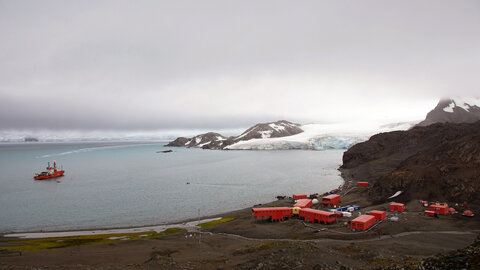The Cold War as a driver of civil aviation

Whether globalisation as such is a positive thing or not is a question that Peter Svik does not answer unequivocally: at any rate, he considers that it also has some positive aspects. One thing he is very certain about, however, is the fact that rivalry between East and West not only transformed civil aviation, but also made new flight routes possible through the development of new engines such as jet and fan-jet engines. “These new engines were originally developed for the air forces of the USA and what was then the USSR in order to improve combat and transport capabilities. Adaptation for civil aviation only occurred in a second step,” explains Peter Svik, a passionate frequent flyer and currently a Schrödinger Fellow of the Austrian Science Fund FWF.
Without the military funding, this development would probably never have taken place, as it was extremely expensive. The historian illustrates this by means of an example: “The cost of developing an atomic bomb was around 1.5 billion dollars. Developing just a single one of these new types of engines cost 2.5 billion dollars only in 1945–46.” Svik says that not even the US Army itself has accurate records of total development costs and he speaks of “at least 30 to 50 billion dollars” – at the value of the dollar at that time.
Trans-Siberian route
It was only because of these improved engines that the range of aircraft increased so much that the flight route over Siberia, which connected Western Europe with Japan and the Far East, could be opened for civil aviation in 1970. In addition, an improvement of East-West relations in late 1960s played here an important role, too. A plane trip to Japan that had in the 1950s taken around one and a half days and in the 1960s up to 20 hours could now be completed in seven to ten hours. “From after the Second World War until the late 1950s, civil aviation used propellers, which limited airspeed and altitude,” Svik explains. “Thereafter, airlines in the West and East adapted jet engines from air forces - the Havilland Comet, Boeing B-707 and Douglas DC-10 in the West, and the Tupolev Tu-104 in the East. Jet engines are extremely noisy, however, and have higher fuel consumption. Since the late 1950s, there has been pressure, especially in the US, Britain and France, to develop quieter and more economical engines.” The fan-jet engines were developed as a result and they have been the industry standard since the 1970s. In the USSR, on the other hand, they were only introduced in the 1990s.
Globalisation
During the Cold War, strategic reasons and power-politics induced the United States and the Eastern Bloc countries to open routes to what was then called the Third World. They also supported airlines in Latin America, Africa and Asia with funding and know-how. As Peter Svik points out, this accelerated the development of aviation in these countries and thus the connections between the “Global South” and the “Global North”. That constituted one of the cornerstones of globalisation. According to the Cold War mindset, passenger safety was secondary; according to Svik, what counted was military security and prestige – following the logic of “being the first and the biggest”.
Svik considers that economic reasons were primarily responsible for the stagnation of Soviet aviation since the late 1950s: “Soviet producers had huge problems designing and producing fanjet engines, and in general the entire Eastern Bloc had problems with automation owing to the introduction of microelectronics.” Microelectronics had been motivated by the “military demand for smaller communication devices”. Once again, the military served as a driver of technology in this context.
Structure of the publication
In eight chapters, the monograph “Civil Aviation and the Globalisation of the Cold War”, which was the result of the FWF-funded Meitner Project, describes the most important developments between the mid-1940s and the end of the 1980s. The publication covers a wide range of topics, including diplomatic and international history, economic and business history and the history of technology. Svik conducted his research on both sides of the Iron Curtain: “I spent a total of about two years in archives and libraries in Washington, London, Munich, Prague and Vienna.” He reports that it was usually no problem to get hold of the documents because “most of them had already been released for research purposes”.
In a second part, the focus of the project was expanded from civil aviation to technologies in general. This part of the project culminated in a major international conference in Vienna in 2018. Currently, Svik is preparing a publication dedicated to the link between the Cold War and technological innovations, including the fields of shipbuilding, oil transport and pipeline construction.
Svik is currently an Erwin Schrödinger Fellow of the FWF at the International History Department, Graduate Institute in Geneva, in cooperation with the Department of East European History at the University of Vienna. He has remained faithful to his favourite subject, aviation, and is researching the Europeanisation of air traffic control since the 1950s.
Personal details
Peter Svik has been a Visiting Fellow at the British Academy in London, at the École normale supérieure in Paris and at the Leibnitz Institute for European History in Mainz, as well as a Guggenheim Fellow at the Smithsonian National Air and Space Museum in Washington and a Marie Curie Fellow at the University of Tartu. Svik studied political science and international history at Comenius University in Bratislava and at the Slovak Academy of Sciences.
Publications
Svik, Peter: Civil Aviation and the Globalization of the Cold War. Palgrave Macmillan 2020
Švík, Peter: Február 1948 a civilná letecká doprava medzi Východom a Západom, in: Soudobé dějiny, 27(1), pp. 100-115, 2020





